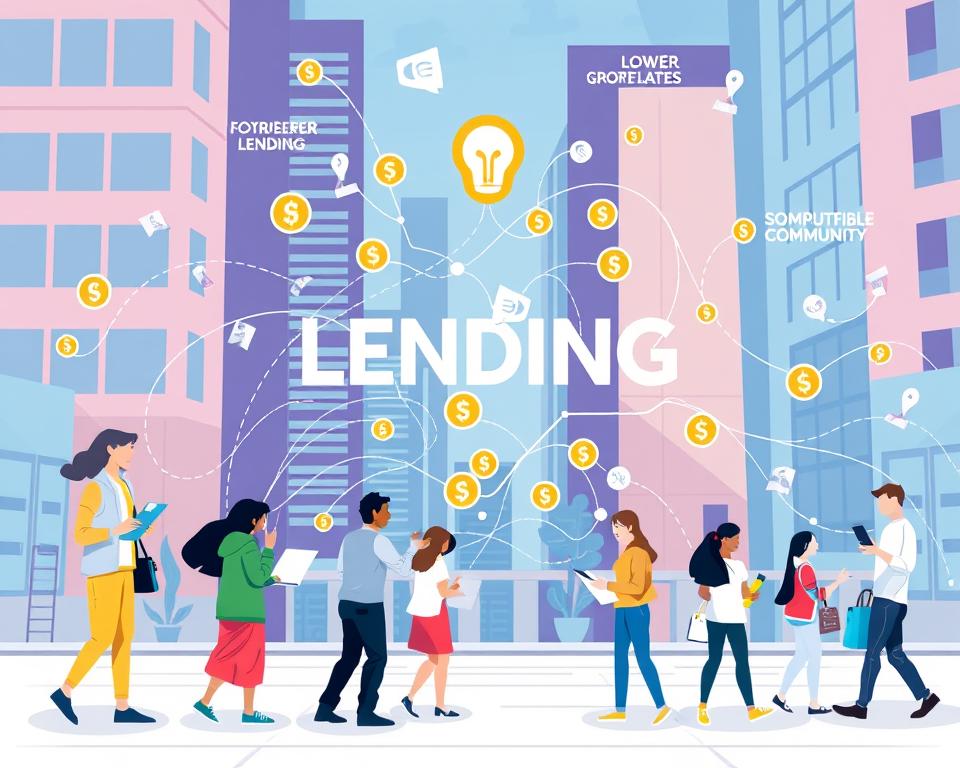Anúncios
In recent years, fintech has grown a lot, changing how banks work. Digital banking and new tech like AI and blockchain are forcing banks to change. These changes are big and show a new direction for finance.

Deloitte found that fintech got $136 billion in investments in 2020. This shows how fast the industry is growing. Banks need to focus on making things better for customers now more than ever.
Key Takeaways
- Fintech is changing how banks do things.
- Digital banking makes things easier and more accessible.
- AI in finance helps with better customer service and personalization.
- Blockchain makes financial dealings more secure and open.
- New payment methods make transactions faster.
- Banks need to keep up with fintech to stay ahead.
Understanding the Fintech Revolution
The fintech revolution is changing how we handle money. It brings new ideas like mobile banking and apps for personal finance. These changes make money services easier and cheaper for everyone.
A McKinsey survey showed 70% of bank leaders think they need new tech to stay ahead. People want banking that’s easy and works well. So, old banks are using new tech to meet these needs.
Key Innovations Transforming Financial Technology
The world of finance is changing fast thanks to fintech innovations. Artificial intelligence is making a big impact in banking. It helps process data better and automates tasks, making banking smoother for everyone.
Big data analytics is also key in making banking personal. It lets banks understand what customers want and offer them just what they need. This makes customers happier and more loyal to their banks.
Blockchain technology is another game-changer. It makes transactions safe and clear. By cutting out middlemen, it builds trust and makes things more efficient. Banks are using it to keep customer data safe, making everyone feel more secure.
Let’s look at a table that shows what each innovation brings to the table:
| Innovation | Key Features | Benefits |
|---|---|---|
| Artificial Intelligence | Data analysis, task automation, predictive analytics | Improved efficiency, enhanced customer service |
| Big Data Analytics | Customer behavior insights, personalized offerings | Increased engagement, better customer retention |
| Blockchain | Decentralized ledger, secure transactions, transparency | Trust enhancement, reduced transaction costs |
These fintech innovations are changing the financial world. They bring accuracy, efficiency, and personalization to banking.
The Rise of Digital Banking
Digital banking is changing how we deal with money. It uses technology to offer many benefits. Yet, traditional banks face challenges in keeping up with these changes.
Advantages of Digital Banking Solutions
Digital banking is popular for good reasons. It lets users access their accounts anytime, anywhere. Here are some key benefits:
- Lower operational costs: Digital banks save money, which means better deals for customers.
- Personalized user experiences: They use smart tech to offer services that fit each customer’s needs.
- Seamless transaction processes: Quick transfers and online payments make things easier for users.
Challenges for Traditional Banks
Traditional banks have their own hurdles to overcome. They need to:
- Adapting to technological advancements: They must innovate while keeping old systems running.
- Overhauling outdated infrastructures: Updating systems is costly and can slow progress.
- Addressing cybersecurity threats: As digital banking grows, so do the risks of cyber attacks.
Traditional banks must find ways to meet customer needs. They face stiff competition from digital banking. It’s crucial for them to adapt and innovate.
Blockchain Technology in the Banking Sector
Blockchain technology is changing the banking world. It makes transactions more transparent and secure. This is key for keeping trust in financial systems.
Banks see blockchain’s power in making cross-border payments faster and cheaper. Traditional methods are slow and expensive.
Big banks like JPMorgan and Goldman Sachs are studying blockchain. They want to use it to cut down fraud and improve record-keeping. Blockchain helps banks save money and speed up transactions.
Blockchain also helps with following rules and checking for fraud. As banking evolves, using these new tools is crucial. It helps banks stay ahead and keep their services safe.
| Aspect | Traditional Banking Methods | Blockchain Technology |
|---|---|---|
| Transaction Speed | Slow (up to several days) | Fast (minutes or seconds) |
| Cost | Higher costs (fees and commissions) | Lower costs (up to 30% savings) |
| Security | Vulnerable to fraud | Enhanced security through encryption |
| Transparency | Limited visibility | High transparency (all transactions are recorded) |
AI in Finance: Enhancing Customer Experiences
Artificial intelligence is changing the financial world by making customer experiences better. Banks and financial companies use AI to understand what customers like and need. This helps them offer services that fit each person’s unique situation.
Personalized Financial Services
Companies like Betterment and Wealthfront show how AI makes financial services better. They use smart algorithms to give advice and plans that are just right for each customer. AI lets them make changes quickly, making the experience more dynamic.
“Enhanced personalization driven by AI can lead to a 10-20% increase in customer satisfaction.”
As more companies use these technologies, they focus on making things easy and fun. They aim to make banking more personal and accessible. This ensures that banking meets the needs and wants of each user.
| Feature | Traditional Services | AI-Powered Services |
|---|---|---|
| Customization | Standardized options | Tailored financial advice |
| User Engagement | Passive interactions | Interactive and real-time feedback |
| Advice Responsiveness | Periodic reviews | Continuous analysis and adjustments |
Payment Solutions: The Future of Transactions
The way we pay for things is changing fast. New payment solutions make paying easier and safer. Contactless payments are becoming more popular, as people want quick and easy transactions.
Contactless Payment Methods
Contactless payments use NFC technology. They let customers pay without touching anything. This is great for those who love fast and easy checkout experiences.
A survey showed many people like contactless payments because they’re simple. Stores are now using these methods to make customers happier and the payment process smoother.
Mobile Wallets and Their Impact
Mobile wallets like Apple Pay and Google Wallet are getting more popular. They offer strong security, like encryption and tokenization, to keep card info safe. As more people use mobile wallets, paying becomes even easier.
This change is big for how we shop. It’s making retail transactions more efficient and convenient for everyone.
Regtech: Navigating Compliance in Fintech
In the fast-changing world of finance, regtech is a key player for companies. It helps them deal with the complex rules of fintech regulations. By using new technologies, firms can make their compliance work smoother.
This is very important for banks and other financial groups. They need to follow strict laws while still working well.
Regtech solutions make tasks like reporting and checking transactions easier. This makes things more efficient and lowers the risk of breaking rules. It can also save a lot of money, with some saying it can cut costs by up to 50%.
Financial groups can improve their compliance by being proactive. For example, Quavo uses special strategies that go beyond just following rules. They show how it’s possible to focus on customer happiness and following rules at the same time.
To find out more about new ways to handle compliance, check out this article.
As fintech keeps growing, the need for regtech in making compliance easier will only get bigger. Companies that use these new tools will likely stand out. They will stay in line with rules and keep their customers happy.
Peer-to-Peer Lending: A New Era of Borrowing
Peer-to-peer lending is changing the way we borrow money. It connects people directly, making loans more accessible and affordable. This new way of lending is a big step forward in finance.

Benefits for Borrowers and Investors
Peer-to-peer lending offers many benefits. Borrowers get lower interest rates, which helps them afford what they need. This could be for personal or business reasons. Investors, on the other hand, can earn more than with other investments.
Some key benefits include:
- Lower interest rates: Borrowers find loans that are more affordable.
- Higher returns: Investors capitalize on better yield opportunities.
- Increased accessibility: A streamlined process eliminates the bureaucracy often encountered with banks.
- Diverse investment options: Investors can choose from various borrowers based on risk profiles.
The growth of peer-to-peer lending is impressive. It’s expected to grow by over 25% each year. This shows how it’s changing the way we borrow and invest. For more information, check out the benefits and trends of this new finance approach.
| Feature | Borrower Benefits | Investor Benefits |
|---|---|---|
| Interest Rates | Lower than traditional banks | Higher returns than savings accounts |
| Accessibility | Simplified application processes | Diverse portfolio options |
| Approval Speed | Quicker loan decisions | Efficient investment flow |
The Role of Fintech in Financial Inclusion
Fintech solutions are key to financial inclusion, especially for those who were left behind. They bring banking services to people who couldn’t access them before. Now, mobile banking and digital wallets help millions worldwide join the economy.
Companies like Kiva and PayPal show fintech’s power to help people. They offer micro-lending, making banking a reality for many in developing countries. The World Bank says about 1.7 billion adults still don’t have bank accounts. This shows fintech’s huge role in filling this gap.
It’s important to watch over fintech as it grows. We must protect those who might get hurt. Teaching people about fintech helps them make smart choices.
As finance changes, we must keep improving how we help people access it. With the right steps, fintech can make finance more inclusive. For more, check out how fintech is driving financial inclusion.
Coping with Cybersecurity in Fintech Innovations
Fintech innovations are changing the financial world, but they also bring big cybersecurity challenges. Financial institutions face threats like phishing, ransomware, and data breaches. These attacks target weaknesses in new technologies.
Studies show these threats are getting worse. By 2025, cybercrime could cost the world about $10.5 trillion a year.
Current Threats in the Financial Sector
Fintech companies are fighting back with better cybersecurity. They use:
- Multi-Factor Authentication: A key way to make sure only the right people get in.
- Encryption: Keeps customer data safe by making it unreadable to others.
- AI-Driven Monitoring Systems: Catch threats fast, helping to stop problems before they start.
Having strong cybersecurity is key to keeping customers safe. It helps protect their financial information. For more on how to improve cybersecurity, check out this article.
Future Trends in Fintech to Watch
The finance world is always changing, thanks to new fintech trends. Areas like quantum computing, artificial intelligence, and decentralized finance (DeFi) are becoming more important. These technologies will change how we make payments, borrow money, and invest.
Artificial intelligence and machine learning are becoming more common. They make banking better for customers and help banks work more efficiently. With these tools, banks can give customers what they want and manage risks better. This is why more money is being spent on these technologies.
Decentralized finance (DeFi) is also growing. It offers new ways to access financial services without banks. This gives people more control and access to money.
As these trends grow, companies need to keep up. They must meet changing customer needs and understand new technologies. This will help them stay ahead in the finance world.
Conclusion
The fintech impact is changing banks and financial institutions. They are using new tech like AI, blockchain, and digital payments. It’s key for them to focus on better customer service and making finance more accessible to everyone.
This change is not just about keeping up with tech. It’s about staying important in a world that’s always evolving. Banks need to adapt to stay ahead.
Traditional banking and fintech are teaming up to bring better services and products. This partnership is crucial for a bright future in banking. By using technology, banks can work more efficiently, keep things safe, and give people better access to financial services.
The future of finance will depend on banks and fintech companies working together. This collaboration can lead to a better financial experience for everyone. It’s a big step towards a more inclusive financial world.
FAQ
What is fintech?
Fintech is short for financial technology. It’s when tech is used to make financial services better for people and businesses. This includes things like online banking, payment apps, and using blockchain and AI in finance.
How does digital banking differ from traditional banking?
Digital banking lets you do all your banking online, without going to a bank. You can send money, manage your accounts, and even apply for loans online. Traditional banking, however, needs you to visit a bank and fill out paperwork.
What advantages do payment solutions offer in today’s market?
Payment solutions like contactless payments and mobile wallets make things easier and faster. They add security and make transactions smooth for everyone.
What is blockchain technology, and how is it used in banking?
Blockchain is a digital ledger that records transactions on many computers. In banking, it boosts security, cuts down on fraud, and makes international transactions cheaper and faster.
Can you explain the term regtech?
Regtech, or regulatory technology, uses tech to help banks follow rules better and cheaper. It automates checks and watches transactions to stop fraud.
How is AI being utilized in financial services?
AI helps in finance by improving customer service with chatbots, giving personalized advice, and automating tasks. This makes banking more efficient and better for customers.
What role does peer-to-peer lending play in the fintech ecosystem?
Peer-to-peer lending connects borrowers with lenders directly, skipping banks. It offers lower rates for borrowers and higher returns for investors, changing how we borrow money.
How is fintech promoting financial inclusion?
Fintech, like mobile banking and micro-lending, brings financial services to those who can’t get them from banks. It helps include more people in the financial world.
What are the current cybersecurity threats faced by fintech companies?
Fintech faces threats like phishing, ransomware, and data breaches. It’s key for companies to invest in strong security to keep customer data safe as fintech grows.
What will be the future trends in fintech to watch out for?
Look out for more AI, machine learning, quantum computing, and decentralized finance (DeFi). Keeping up with these trends helps fintech companies stay ahead and meet changing customer needs.



